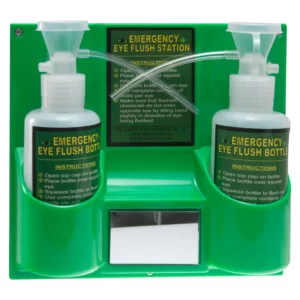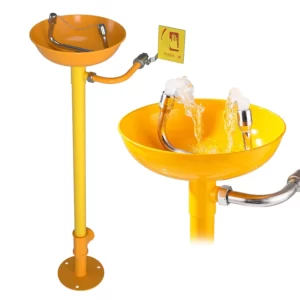Why are emergency showers or Eye Wash Station important?
The first 10 to 15 seconds after exposure to a hazardous substance, especially a corrosive substance, are critical. Delaying treatment, even for a few seconds, may cause serious injury.
Emergency showers and Eye Wash Station provide on-the-spot decontamination. They allow workers to flush away hazardous substances that can cause injury.
Accidental chemical exposures can still occur even with good engineering controls and safety precautions. As a result, it is essential to look beyond the use of goggles, face shields, and procedures for using personal protective equipment. Emergency showers and Eye Wash Station are a necessary backup to minimize the effects of accident exposure to chemicals.more
What is considered to be a ‘flushing fluid’?
The ANSI standard defines “flushing fluid” as any of potable (drinking) water, preserved water, preserved buffered saline solution or other medically acceptable solutions. Local laws may apply in some cases. This document will use the term “water” to mean any of these acceptable flushing fluids unless otherwise specified.
How long should the contact area be rinsed/flushed?
ANSI Z358.1-2014 does not specify how long the affected body part should be rinsed. It does specify that the equipment installed according to the standard be capable of providing flushing liquid for a minimum of 15 minutes.
However, other references recommend a minimum 20-minute flushing period if the nature of the contaminant is not known. The flushing or rinsing time can be modified if the identity and properties of the chemical are known. For example:
- 5-minutes for non-irritants or mild irritants,
- 15-20 minutes for moderate to severe irritants and chemicals that cause acute toxicity if absorbed through the skin,
- 30 minutes for most corrosives, and
- 60 minutes for strong alkalis (e.g., sodium, potassium or calcium hydroxide).
In all cases, if irritation persists, repeat the flushing procedure. It is important to get medical attention as soon as possible after first aid has been given. A physician familiar with procedures for treating chemical contamination of the eyes and body should be consulted.
What are examples of areas that may require this equipment?
Work areas and operations that may require these devices include:
- Battery charging areas
- Laboratories
- Spraying operations
- High dust areas
- Dipping operations
- Hazardous substances dispensing areas
Are there any limitations I should be aware of?
Plumbed Emergency Showers and Eye Wash Station
Studies have shown that despite a general minimum of 15-minute flushing time being recommended, users usually flush exposed body parts five minutes or less. The reasons were always related to the extreme discomfort users experienced using cold water. In cold climates, the water temperature in indoor plumbed systems can be in the 2-7°C (35-45°F) range.
Be sure to maintain the equipment. ANSI suggests a weekly activation to help reduce sediment and/or stagnant water issues.
Portable, Self-Contained Eye Wash Station
Portable, self-contained eyewash stations have a limited amount of fluid. As a result, maintenance is critical to ensure that units are fully charged at all times.
These Eye Wash Station also require ongoing maintenance of the flushing solution. The agents used to control bacterial growth are effective for certain limited periods of time. Also, small amoebae capable of causing serious eye infections have been found in portable and stationary eyewash stations. Consequently it is important to monitor the shelf life of the solution and replace the solution when it has expired.
Eyewash Bottles
Eyewash bottles or personal eyewash units supplement plumbed and self-contained stations, but in no way can replace them. They are portable and permit immediate flushing of contaminants or small particles. However, eyewash bottles are very difficult for the user to handle, especially when alone and when both eyes have been exposed. (e.g., holding the eyelids open while handling the unit is awkward). Also, one bottle cannot flush both eyes simultaneously. Since the fluid supply lasts for only a short period of time, the bottle may not able to wash the eyes sufficiently.

The main purpose of such a unit is to supply immediate flushing. Once accomplished, the user should proceed to a self-contained or plumbed eyewash and flush for the required flushing/ rinsing period.
Eye Wash Station Price in Pakistan
They should be properly maintained on regular basis to ensure availability in case of accident. To know the Eye Wash Station price start from PKR 35k to PKR 60k . Pease contact our sales team or WhatsApp 0345 7772324 and further details.


